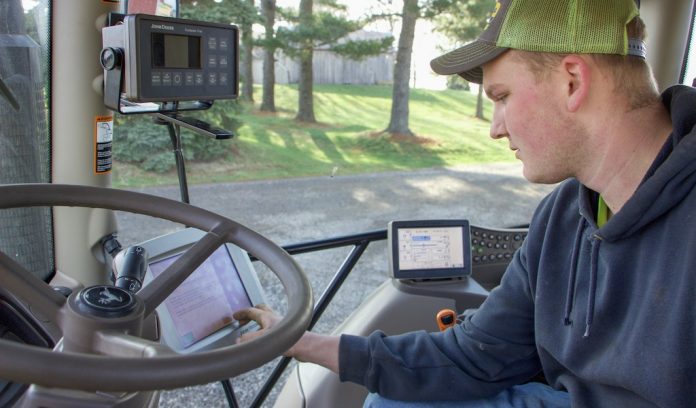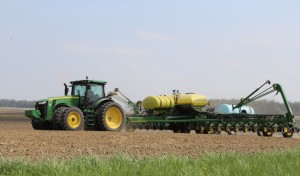
SALEM, Ohio — Precision agriculture and agricultural technology have come a long way in the past five to 10 years.
According to Scott Shearer, chair of Ohio State’s College of Food, Agriculture and Biological Engineering, there are a lot of technologies that have made money for farmers, but every farm is different.
Yield monitors
The yield monitor itself, although not new technology, allowed farmers to quantify yield differences, said Shearer. “(Farmers) always knew there were problems in the field with less yield (in some areas of the field), but they didn’t know how much it was costing them,” he said.
Randy Campbell, of Minerva, Ohio, said he is impressed with what his yield monitor can do. When he purchased it four years ago, he didn’t know it would tell him about the downforce, or soil compaction, caused by his equipment and allow him to make easy adjustments from the cab.
Campbell farms 2,800 acres of corn, soybeans and some hay, and milks around 70 head of Holsteins. He uses his monitor for both planting and harvest season.
In-cab displays and instant feedback has been around for some time now, but, according to John Fulton, associate professor in the College of Food, Agriculture and Biological Engineering, more farmers have been adapting the technology in the last five years.

Autosteer and GPS
More farmers are opting for GPS and autosteer technologies, and most new farm equipment comes equipped with these features. Shearer said autosteer has value in reducing overlap in planting, but it has also enabled farmers to use farming practices they couldn’t before, such as strip tilling and banding.
Campbell said he started strip tilling around eight years ago, tilling a strip ahead of the planter and going back to plant into that strip. “When you come back and try to follow that path, it’s hard to replicate,” he said. Guidance has made a big difference.
“Even with the hillside, it can do adaptive curves, once you set those curves,” adds Jim Kiko, who farms 750 acres of corn, beans, wheat and alfalfa, and milks 140 head of Holsteins, in Paris, Ohio.
“It’s a lot easier to go back and sidedress with straight rows,” he said. “Before, especially on adaptive curves, we might take a whole row out.”
Wes Montgomery, of Washington Court House, Ohio, said his family started using GPS on their farm in 2009. They farm 1,500 acres of corn and beans in Fayette County. “We work with GPS a lot,” said Montgomery. “It’s more of a convenience, like autosteer. You are more rested, but you’re not getting much of a return off it until you build onto that basic GPS.”
Kiko said the investment in GPS is minimal compared to the headache of using manual markers in field rows. “We no-till into rye stubble, and (before GPS) we would drive a marker down into that stubble,” said Kiko. “When we double crop, we couldn’t see the marker at all and we couldn’t plant at night.”
He added it’s hard to go backward, once you start investing in these technologies.
Automatic section control
Coupled with GPS and autosteer, automatic section control (sometimes referred to as automatic shut off) on planters and sprayers helps reduce and eliminate overlap in fields.
According to Shearer, some producers may see a 6-12 percent saving on inputs when they use it. “Large, open, rectangular fields are not going to see as much savings, but those uniquely shaped fields with waterways are more likely to,” he said.
Montgomery uses section control on planters and sprayers and said they have been able to reduce overlap by about 10 percent.
“Most producers are running bigger machines (these days),” said Fulton. “With guidance and auto section control, those machines can be more efficient.” Producers find themselves spending less time in the fields and “they’re not as fatigued,” he said. “There is a quality of life component as well.”
Kiko said, while it’s costly to update older equipment, if he were to upgrade his planter, he would get one with this technology.
Variable rate fertilizer
“Variable rate and soil testing are the least expensive ways to start into precision ag,” said Campbell.
However, “variable rate technology is not going to pay for everybody,” said Shearer. The biggest benefits will be for farmers who have the most disparity in their fields.
With water quality issues being a concern, Montgomery and his family recognized they were getting too much nutrients. Today, his farm uses pretty much all variable rate fertilizer. “Variable rate fertilizer pays off pretty good. We aren’t putting any more fertilizer on the field on average, but we can put more where it is needed in the field,” said Montgomery.
Kiko said they are still averaging the same amounts of lime, phosphorus and potassium per acre, but using a mapping and variable rate system, they know they are doing a better job of putting those nutrients where they are needed. “I don’t know that we are saving money on product, but we are getting more out of it,” he said.

Variable rate seeding
Variable rate seeding has also become a popular technique on many farms.
“We are finally starting to do some variable rate seeding,” said Campbell. In the past couple of years, he used grid sampling to break his fields into zones using historical yield data and soil type to establish those zones.
“I load that into the computer and it gives me a prescription to put into the planter and it does it automatically,” he said.
As far as cost savings go, Campbell said, “corn and beans are two different variable rate animals.” With corn, Campbell found using variable rate just reallocated the seed to where it was needed, while he found he needed fewer soybean seeds.
Montgomery said their farm also intensively manages seeding. “Variable seeding lowered our average soybean seeding dramatically and we are still seeing good yields.”
Smartphones, tablets and apps
While smartphones and tablets are not a new technology, they are finding more favor in the farm world. “More and more people are doing business with them,” said Fulton.
From monitoring the weather to checking the markets, and even running diagnostics on a piece of equipment, this technology is becoming more user friendly.
“On the app side, I don’t know if anybody is making money, but collecting information, or smart scouting, is huge,” said Fulton.
Big data
Big data is still being fine tuned. Some farmers are still a little skeptical of having all their farm information compiled in a cloud service, while others are unsure how to truly understand and navigate it all.
“For the most part, the data that we use is pretty simple, and pretty user friendly,” said Kiko. “We’ve got enough information to know what we need to do in our fields,” said Kiko.
Unfortunately, Mother Nature still plays the biggest role in all this, he added. Campbell said he was hesitant to embrace the technology at first, but working with a local co-op made it easier to break down his data and decipher it.
At the end of the day, “you got to know your fields,” said Campbell. “When you are the guy in the fields, you can see what the data is telling you — which makes it easier to manage and break down for yourself.”
Software is going to get better and these technologies are going to become more affordable for the small to mid-size farmer as time goes on, said Campbell.
Precision agriculture and new ag technology is not a one-size-fits-all management tool, but the world of agriculture technology is advancing quickly, and it fits more farms than you think.











and if her children partake in RR gene seed and other double stranded dna technology ..her children no run the risk of 1/ 49 to get autism or worse risk on double stranding in dna food..before RR genes these risks were 1/172,000 now after 25 years of Monsanto the countries that feed this poison to there people and pay off there local senators and reps..like here to hide this food supply shift over the profits the farmers make to hundreds of billions in medical expenses in alzheimer’s, autism to the medical cost shift.. but yes factory farms who don’t care about people make money..